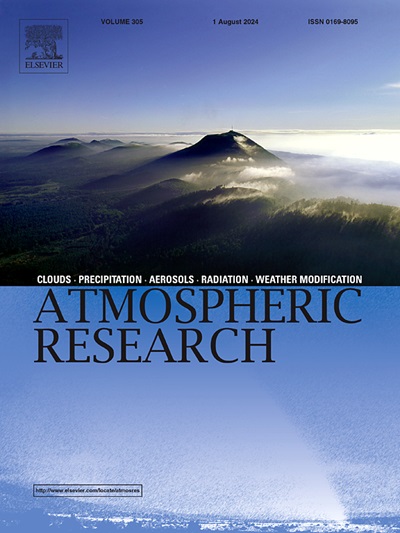在冷空气爆发期间层积云到积云的转变:气溶胶的作用
IF 4.5
2区 地球科学
Q1 METEOROLOGY & ATMOSPHERIC SCIENCES
引用次数: 0
摘要
冷空气爆发(CAOs)是冬季发生在高纬度地区的现象,有利于广泛边界层云的发展。随着边界层的演变,云形态的变化往往导致层积云向积云转变(SCT)。降水的开始被认为是导致层积云甲板破裂的关键因素。在本模型研究中,我们通过使用气溶胶和云滴数浓度(Nd)的预测场,研究了在北大西洋CAO事件中气溶胶对SCT的额外作用。通过使用两种化学/气溶胶方案,我们评估和量化了气溶胶对SCT演变的影响。我们的研究结果表明,气溶胶负荷及其化学成分影响降水开始的时间和强度,从而影响破碎。然而,两种方案显示出矛盾的结果,这主要与不同的气溶胶大小和化学成分在模式和箱之间的分配有关。采用考虑模态方法的气溶胶方案的模拟表明,整个SCT的Nd减少是由云中液态水含量、硫酸盐有效性和积云区域的细海雾有效性的变化驱动的,这些变化抑制了硫酸盐的活化。Nd的减少主要随累积型气溶胶的减少而减少。对于考虑截面方法的方案,层积云和积云都对新粒子的形成及其对水的竞争表现出敏感。然而,在积云区域,较高的上升气流和更大的细海盐颗粒的可用性对小颗粒的激活至关重要。在这种原始环境中,新颗粒的形成和背景硫酸盐浓度至关重要,而海盐颗粒在两组模拟中都对SCT有重大影响。本文章由计算机程序翻译,如有差异,请以英文原文为准。
A stratocumulus to cumulus transition during a cold-air outbreak: The role of aerosols
Cold air outbreaks (CAOs) are phenomena that occur across high latitudes during winter months and favor the development of extensive boundary layer clouds. As the boundary layer evolves, changes in cloud morphology often result in a stratocumulus to cumulus transition (SCT). The onset of precipitation is considered to be a key factor that leads to the break-up of the stratocumulus deck. In this modeling study we investigate the additional role that aerosols have on the SCT within a CAO event in the North Atlantic, by using prognostic fields for both aerosols and cloud droplet number concentrations (Nd). By using two chemical/aerosol schemes we assess and quantify the impact of aerosols on the SCT evolution. Our results indicate that the aerosol load and its chemical composition affect the timing of precipitation initiation and its magnitude and thus the break-up. However, the two schemes reveal contradictory results, which are mainly associated with different aerosol size and chemical composition partitioning between modes and bins. The simulations with the aerosol scheme, which considers the modal approach, show that the reduction of Nd across the SCT is driven by changes in the cloud liquid water content, the sulfate availability, and the fine sea-spray availability in the cumulus region, which suppresses sulfate activation. The Nd decreases mostly follow the decrease in accumulation-mode aerosols. For the scheme that considers the sectional approach, both the stratiform and the cumulus clouds appear sensitive to new particles formation and their competition for water. However, in the cumulus region, the higher updrafts and the greater availability of fine sea salt particles become critical for the activation of small particles. New particle formation and background sulfate concentrations are critical in this pristine environment, while sea salt particles have a significant impact on SCT in both sets of simulations.
求助全文
通过发布文献求助,成功后即可免费获取论文全文。
去求助
来源期刊

Atmospheric Research
地学-气象与大气科学
CiteScore
9.40
自引率
10.90%
发文量
460
审稿时长
47 days
期刊介绍:
The journal publishes scientific papers (research papers, review articles, letters and notes) dealing with the part of the atmosphere where meteorological events occur. Attention is given to all processes extending from the earth surface to the tropopause, but special emphasis continues to be devoted to the physics of clouds, mesoscale meteorology and air pollution, i.e. atmospheric aerosols; microphysical processes; cloud dynamics and thermodynamics; numerical simulation, climatology, climate change and weather modification.
 求助内容:
求助内容: 应助结果提醒方式:
应助结果提醒方式:


